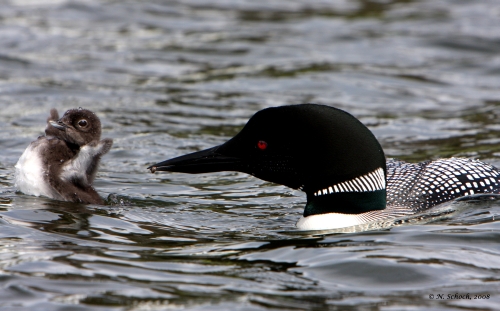 Common Loon (Gavia immer) courtesy Biodiversity Research Institute
Common Loon (Gavia immer) courtesy Biodiversity Research Institute
Albany, NY–An extensive study of New York’s Adirondack loon population has revealed that mercury contamination can lead to population declines of the iconic bird. The research effort was a joint project between the New York State Energy Research and Development Authority (NYSERDA), the Biodiversity Research Institute (BRI) and the Wildlife Conservation Society (WCS).
For nearly 10 years, researchers from these organizations followed mercury contamination throughout the aquatic food chain, from zooplankton to the Common Loon, in Cranberry and Lows lakes as well as in other bodies of water. They found that loons with elevated mercury levels produced significantly fewer chicks than those with low mercury levels, particularly those breeding on the more acidic lakes that are common in the Adirondack Park. Go here to read the full report.
In December of 2011, the U.S. Environmental Protection Agency (EPA) finalized the Mercury and Air Toxics Standards Rule that requires coal-fired power plants to update their mercury pollution control technologies. However, overseas emissions are also a problem. BRI scientists have been involved in helping to inform mercury emissions policy on both domestic and international levels.
“The good news is that efforts to control mercury pollution here in the United States have been very beneficial, as we have discovered in our extensive mercury studies throughout the Northeast and in the Great Lakes region,” says David C. Evers, Ph.D., executive director and chief scientist of BRI. “One of BRI’s core missions is to support the policymaking process with good science. Our findings in this loon study demonstrate the need for the EPA’s ruling and highlight the importance of mercury tracking through better national and international monitoring programs.”
Common Loons are widely-recognized symbols of northern wilderness and indicators of aquatic health. To understand their popularity with the public, all you need to do is here their “wail call.”
Or one of their other endearing calls of the wild.
You can listen to a recent report from NPR as this group goes out to band these 12 to 15 pound birds.









Comments on this entry are closed.
That is distressing! I hope there’s something that can be done to help them and that we do it. If they’re in trouble, it seems likely that there are also other species that are in trouble too…
@Lisa thank you for your comment. It reminded me that I forgot to put one of the summery statements of the report into my post. With the help of the EPA to cut mercury pollution in the U.S., the BRI is showing progress with better national and international monitoring.
Thanks for sharing that inevitable and sad story Larry. I have to say that this is one of those occasions when I prefer the NA name to our own (GND of course). The name Common Loon evokes so much mystery, intensified by that wonderful call. I hope the US can make progress with this troubling issue, for all of our sakes.
It is so sad to hear this. It was such a thrill to see these beautiful birds when we traveled, I will never forget them.